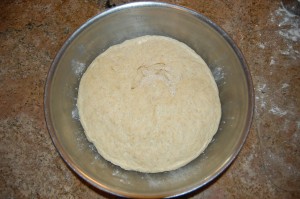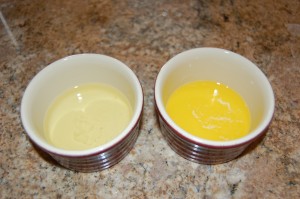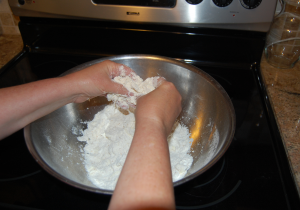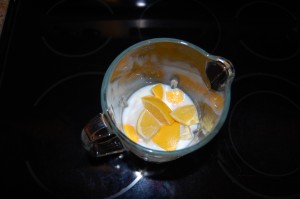
Mom baked these crescent rolls for us during Winter holidays, and making them always makes me feel close to her. They’re rich, fluffy, and time consuming to make, so this is generally a once-a-year treat for me. Making them with friends or family is really fun. Mom’s recipes always yield a lot so you’d have plenty to share. This recipe makes 48 rolls, and they freeze well.
Ingredients:
1 package dried baking yeast
1 tablespoon sugar
1 cup warm water
3/4 cup evaporated milk (room temperature)
1/3 cup sugar (I use 1/4 cup)
3 eggs (or use two and reserve one egg white)
1 teaspoon salt
1-1/3 stick butter, divided (1 stick softened, room temperature and 1/3 stick melted)
6 or more cups of unbleached white flour (I substitute 1 or 2 cups whole wheat for some white.)
sesame and poppy seeds, about 1-1/2 tablespoons of each
Preparation:
In a large bowl, dissolve the yeast and sugar in the warm water. Set the bowl in a warm place for 15 minutes and let it bubble. In a blender, blend together the evaporated milk, sugar, salt, eggs (sans shells), and the softened stick of butter. Add this mixture to the bowl of bubbled yeast and stir. Add the flour to the bowl a cup at a time. When the mixture gets too hard to stir and begins to look like dough, turn it out onto a floured surface and knead until smooth. Wash and lightly grease the bowl. Return the dough to the bowl and cover with a damp towel. Let rise in a warm place until doubled in volume.

Turn risen dough out onto a floured surface and knead a little.

Flatten dough a little with your hands, cover with the inverted bowl, and let rest a few minutes. Meanwhile, put the sesame seeds and poppy seeds nearby.

Melt the 1/3 cup of butter. Add a little water to the third egg (or to the reserved egg white) and whisk.

Take the bowl off the dough. Set the bowl aside and roll the dough into a circle. Divide the circle into six parts.

Roll each part into a ball. Set five of the balls back into the bowl and cover with the damp cloth.

Keep one ball of dough on the floured surface. Flatten that ball into a circle with your hands.

With a rolling pin, roll the dough into a 10-inch circle. Using a pastry brush or your fingers, brush melted butter all over the surface of the circle. With a sharp knife, cut the circle into eight triangles.

Roll one triangle up from the outer edge to the tip.

Shape that triangle into a crescent.

Set the crescent on a greased baking sheet, carefully keeping the tip of the triangle underneath the crescent. (Otherwise, the crescent may unfold as it rises and bakes.) Repeat until you use all the triangles and have eight crescents. With a pastry brush or your fingers, brush each crescent roll with the egg mixed with water. Sprinkle the crescent rolls with sesame seeds or poppy seeds and leave some rolls plain. The egg wash helps the seeds adhere and also enhances the baked rolls’ golden color. Take another ball of dough from the bowl and repeat this process. You’ll end up with 48 crescents. Let the crescents rise on the baking sheets about 20 minutes before you bake them.
You can begin baking risen rolls while you continue assembling the rest. Or you can make some rolls and store some unshaped balls of dough in your refrigerator up to four days and make them later. I’ve also tried shaping the rolls and storing them in the refrigerator to bake later. Results are best, though, I feel, when you bake the rolls and freeze them already made.

Bake the risen rolls in a preheated oven at 350 degrees for about 15 to 20 minutes. The crescents are done when the bottoms are golden and the tops are light brown. Remove from baking sheets to cooling racks.
























































